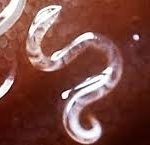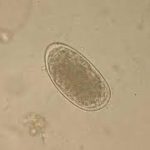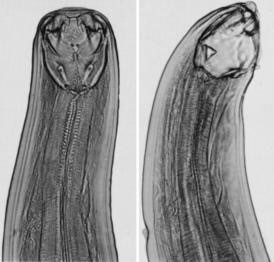Hookworms and Preventative Medications During the Cold Weather
Does your dog or cat receive preventative medications during the cold weather? If not, here is one reason you should  continue your heartworm prevention year round. Heartworm medications also deworm for common intestinal parasites such as hookworms, roundworms, and sometimes whipworms. At Friendship, we’ve been seeing a significant number of patients that test positive for hookworm infection. Hookworms are a common parasite and prolific egg producers. In dogs and cats that have diarrhea from the infection, the eggs are often shed for several days before the onset of signs. Sometimes, infected dogs and cats show no outward signs of infection and shed large numbers of eggs into the environment continuously. Right now the eggs are just hanging out under the snow, but next week as the weather warms and the ground becomes even more moist, the conditions will be perfect for a bloom of hookworm larvae. Want to know more about hookworms and how to protect your pet? Keep reading.
continue your heartworm prevention year round. Heartworm medications also deworm for common intestinal parasites such as hookworms, roundworms, and sometimes whipworms. At Friendship, we’ve been seeing a significant number of patients that test positive for hookworm infection. Hookworms are a common parasite and prolific egg producers. In dogs and cats that have diarrhea from the infection, the eggs are often shed for several days before the onset of signs. Sometimes, infected dogs and cats show no outward signs of infection and shed large numbers of eggs into the environment continuously. Right now the eggs are just hanging out under the snow, but next week as the weather warms and the ground becomes even more moist, the conditions will be perfect for a bloom of hookworm larvae. Want to know more about hookworms and how to protect your pet? Keep reading.
Hookworm Infection
Hookworms are a nematode parasite that is common throughout the U.S. They are short [6- to 12-mm], thick worms that are whitish to reddish brown with a hooked front end. They colonize the small intestines and live by attaching to the mucosal lining and sucking blood.
 The infection is transmitted when an immature hookworm (larva) penetrates the skin or is ingested. Skin penetration occurs most commonly on the feet and belly by coming in contact with contaminated soil. Dogs and cats may ingest contaminated dirt when grooming or eating something off the ground. They can also ingest larvae by eating an infected animal. This could be a rodent, or an insect such as a cockroach. Puppies and kittens can also be infected through the placenta or the mother’s milk.
The infection is transmitted when an immature hookworm (larva) penetrates the skin or is ingested. Skin penetration occurs most commonly on the feet and belly by coming in contact with contaminated soil. Dogs and cats may ingest contaminated dirt when grooming or eating something off the ground. They can also ingest larvae by eating an infected animal. This could be a rodent, or an insect such as a cockroach. Puppies and kittens can also be infected through the placenta or the mother’s milk.
After skin, via skin penetration, the larvae migrate through lungs and up the trachea where they are swallowed to arrive in the gastrointestinal tract. Larvae that are swallowed have a more direct route to the stomach and intestines. After the larvae arrive, they penetrate the intestinal wall where they mature into adults and then return to the intestine to attach to the intestinal mucosa. Not all the larvae mature, some invade skeletal muscle cells or gut wall and enter an arrested state of development. Arrested larvae can later become reactivated and migrate either to the small intestine or to the mammary glands.
Signs: Affected adult dogs and cats may not show any outward signs. But some dogs may develop diarrhea, and in severe cases, anemia and weight loss can be seen. Affected puppies and kittens may be more susceptible to illness and may develop diarrhea with a dark, tarry appearance from digested blood, they may become anemic, may not gain weight and may have a poor hair-coat.
Treatment: Commonly used anthelmintic medications kill the adults present in the intestines. The treatment is  repeated in 3 weeks to eliminate adult hookworms that were larva at the time of the initial treatment. Severely affected animals may also need supportive care for diarrhea, dehydration, and anemia.
repeated in 3 weeks to eliminate adult hookworms that were larva at the time of the initial treatment. Severely affected animals may also need supportive care for diarrhea, dehydration, and anemia.
Deworming does not kill the larvae arrested in the tissues. The intestinal tract can be repopulated by dormant larvae from the tissues that periodically become activated and resume development.
Because of the zoonotic potential of hookworms, antihelmintic treatment is recommended for all puppies and kittens, even if fecal floatations are negative for eggs.
Zoonosis: Adult hookworms do not infect people, but larvae can penetrate and migrate through the skin, causing elevated winding tracts that are intensely itchy. People most at risk are those living in warm coastal clients and those exposed to contaminated soil or sand such as farmers, gardeners, landscapers, sunbathers lying on sand, plumbers, electricians, exterminators, and children playing in potentially contaminated areas.
Prevention: Puppies and kittens should be dewormed routinely during their examinations and then monthly. Adult dogs and cats should continue to receive a monthly parasite control product that is effective against hookworms. These products include Heartgard Plus®, Interceptor®, Sentinel®, Advantage Multi®, Trifexis®, Iverhart Plus®, Iverhart Max®, Tri-heart®, and Revolution®.7
To help decrease environmental contamination with ascarid eggs, feces should be removed and disposed of promptly. In the environment, larvae don’t die until temperatures plummet to about 5ºF. Preventing ingestion of rodents can help reduce risk of infection. Proper hygiene, including hand washing, must be practiced when handling feces. Other preventive measures include: covering sandboxes when not in use, wearing shoes and gloves while gardening, washing hands thoroughly after playing outside or exposure to soil, keeping dogs on leashes or in fenced yards, and keeping cats indoors.
For more information on hookworms visit:
Companion Animal Parasite Counsel
http://www.capcvet.org/capc-recommendations/hookworms
Veterinary Partner
http://www.veterinarypartner.com/Content.plx?A=1530
CAPC Parasite Prevalence Map
http://www.capcvet.org/parasite-prevalence-maps
 Dr. Dana Kuehn joined Friendship in 2005 and is our Chief of Primary Care Services. She is originally from Minnesota, where she completed a BS in biology and graduated from the University of Minnesota College of Veterinary Medicine in 1995. She completed a rotating internship in small animal medicine and surgery in Hollywood, Florida and continued on as an associate in the practice for 10 years. Her professional interests include endocrinology, ophthalmology, soft tissue surgery, and urology.
Dr. Dana Kuehn joined Friendship in 2005 and is our Chief of Primary Care Services. She is originally from Minnesota, where she completed a BS in biology and graduated from the University of Minnesota College of Veterinary Medicine in 1995. She completed a rotating internship in small animal medicine and surgery in Hollywood, Florida and continued on as an associate in the practice for 10 years. Her professional interests include endocrinology, ophthalmology, soft tissue surgery, and urology.
*Featured image courtesy of Drs. Foster and Smith.
